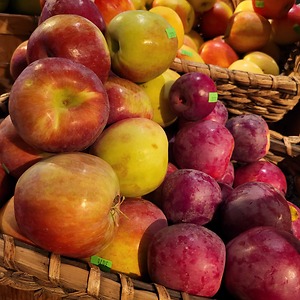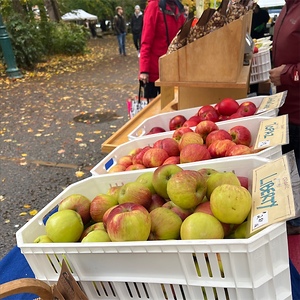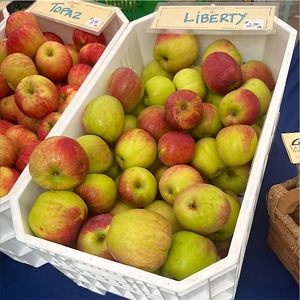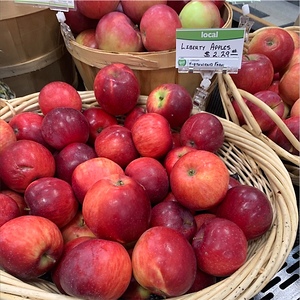


Liberty Apples
Estimated Inventory, lb : 0
Description/Taste
Liberty apples are a medium to large varietal, averaging 6 to 8 centimeters in diameter, and have an oblate to conical, sometimes irregular shape with broad, flat shoulders tapering to a narrow base. The apple's skin is semi-thin, glossy, smooth, and taut, and the stem cavity encases some textured russeting and a short, dark brown-green stem. The fruit's shoulders are slightly ribbed, and the surface has a yellow-green base, almost entirely enveloped in a dark red, striated to striped blush. The skin is also speckled with pale yellow lenticels, and with extended storage, a layer of grease may form on the surface. Underneath the skin, the ivory-to-pale yellow flesh is dense, aqueous, and fine-grained, with a crisp and crunchy consistency. The flesh also contains a medium-large fibrous core filled with black-brown seeds. Liberty apples release a vinous, cider-like aroma and have a refreshing, sprightly, and balanced sweet-tart taste with citrus and melon nuances. As the apples are kept in storage, their sharp notes mellow.
Seasons/Availability
Liberty apples are available in the mid-fall.
Current Facts
Liberty apples, botanically classified as Malus domestica, are an American variety belonging to the Rosaceae family. The late-season cultivar was developed through the New York Agricultural Experiment Station in Geneva, New York, in the mid to late 20th century. Liberty apples were designed through traditional crossbreeding techniques to be an improved cultivar with increased disease resistance. The variety is resistant to the four major apple diseases, including scab, powdery mildew, cedar apple rust, and fire blight, allowing the trees to be grown without pesticides. Liberty apples are also highly productive, and the tree can be grown in standard, semi-dwarf, and dwarf sizes. The trees bear fruit approximately 3 to 4 years after planting, and consumers favor the fruits for fresh and cooked dishes. Liberty apples were named for their freedom from disease and after the town of the same name in New York State. All the apple varieties created at the experiment station are traditionally named after cities in the state. In the modern day, Liberty apples are a popular home garden variety. The apples are harvested in a short timeframe as they have a habit of ripening simultaneously and are sold as a versatile variety for fresh and cooked culinary preparations.
Nutritional Value
Liberty apples are a source of fiber to regulate the digestive tract, vitamin C to strengthen the immune system, and potassium to balance fluid levels within the body. The variety also provides vitamin A to maintain healthy organ functioning, vitamin E to protect the cells against free radical damage, iron to develop the protein hemoglobin to transport oxygen through the bloodstream, and other nutrients, including calcium, phosphorus, zinc, copper, boron, and magnesium.
Applications
Liberty apples have a sweet-tart flavor suited for fresh and cooked preparations. The variety is typically consumed straight out of hand, and the skin can be eaten or discarded, depending on preference. Liberty apples can also be shredded into slaws, chopped into salads, diced into fruit medleys, or layered in sandwiches as a crunchy addition. Try adding Liberty apples as a topping over oatmeal, pancakes, or parfaits or blending into smoothies and juices for a sweet and tangy taste. In addition to fresh preparations, Liberty apples hold their shape when cooked and are popularly baked whole, stuffed with spices, brown sugar, and nuts. The apples can also be incorporated into tarts, pies, muffins, and bread, sauteed with browned butter and spices, or stewed to create a decadent dessert. In the Northeastern United States, Liberty apples are pureed into applesauce and are served with roasted meats as a side dish. The variety is also roasted with root vegetables or minced into stuffing. Liberty apples pair well with nuts such as almonds, walnuts, and pecans, spices including cinnamon, cloves, and nutmeg, meats such as beef, pork, and poultry, and herbs including rosemary, thyme, mint, and parsley. Whole, unwashed Liberty apples will keep for 3 to 4 months when stored in a cool, dry, and dark place such as a cellar or refrigerator.
Ethnic/Cultural Info
The New York State Agricultural Experiment Station, abbreviated to NYSAES, is a famous breeding program within the United States. The station was established as an independent state institution under the Department of Agriculture in 1880 and was created to conduct research and breeding to advance agriculture in New York State. It was also established to develop a network between growers. During this time, agriculture accounted for over half of the labor force in New York and was one of the largest industries in the state. In 1882, the station began releasing weekly bulletins to agricultural news outlets, growers, scientists, and industry professionals, sharing the work being completed within the state. By 1896, over 3,088 varieties of fruits were being grown at the experiment station. In 1923, the station became a part of Cornell University's College of Agriculture and Life Sciences. Beyond releasing notable apple cultivars, including Liberty apples, the New York State Agricultural Experiment Station published a series of monographs from 1905 to 1925 as a feature in their annual reports. The first few publications included a two-volume Apples of New York report written by station horticulturalist Spencer Ambrose Beach. This publication is still referred to for research in the modern day and is noted for its detailed cultural and botanical records.
Geography/History
Liberty apples are native to the United States and were created at the New York State Agricultural Experiment Station in Geneva, New York. The experiment station is a part of Cornell University, and the apple variety was developed from a partnership between the Department of Pomology and Viticulture and the Department of Plant Pathology. This partnership was established to create apple varieties with increased disease resistance using crabapple species or Malus floribunda. In 1955, Dr. Ralph Shay of Purdue University in Indiana gave the New York State Agricultural Experiment Station pollen for a cross between Purdue 54-12, a Japanese flowering crab apple, and a Macoun apple, a McIntosh-style varietal. From the cross, 261 seeds were planted and tested for their resistance to scab, the main disease the experiment station was protecting against. As the trial progressed, it was also determined that resistance to other diseases, including fire blight, cedar apple rust, and mildew, was important in a new variety. Thirty-eight seedlings were selected, and one seedling, labeled NY 55140-19, fruited in 1961 and was propagated for additional trials in 1964. This seedling was eventually chosen for commercialization and was named Liberty, released to the public in 1978. Liberty apples were the first variety created in the two Cornell Departments' partnership, and the apple was marketed as a commercial and home garden cultivar. Today, Liberty apples are primarily grown in the Northeast and Pacific Northwest of the United States. When in season, the apples are sold through farmer's markets, distributors, and specialty grocers.
Recipe Ideas
Recipes that include Liberty Apples. One











